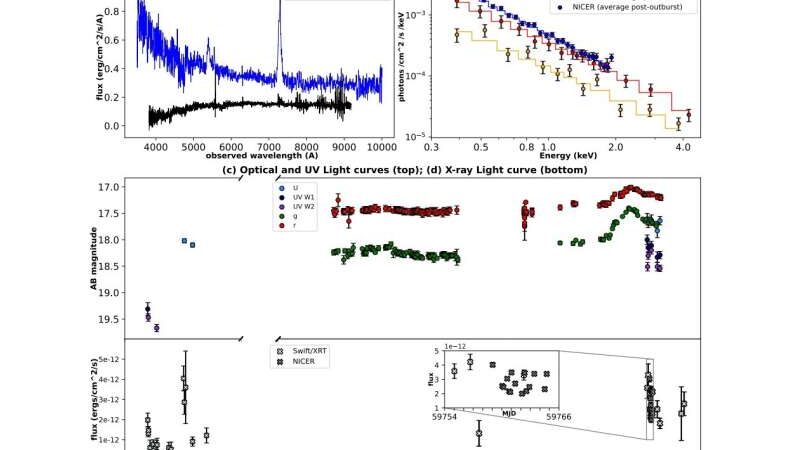AT2021fxu is a changing-look active galactic nucleus

AT2021fxu is a changing-look active galactic nucleus (AGN). By analyzing data from NASA’s Swift spacecraft and NICER on the International Space Station, astronomers have revealed its true nature.
According to the results of the study, published on December 14 on the arXiv preprint server, deliver important insights into the nature of this transient, revealing that it is a changing-look active galactic nucleus. It is a type of AGN which transitions between different spectral types, with an optical outburst marking the onset of this transition.
What is Active Galactic Nucleus?
Active galactic nucleus or AGN is a compact region at the center of a galaxy, more luminous than the surrounding galaxy light. They are very energetic due either to the presence of a black hole or star formation activity at the core of the galaxy, and are generally divided into two groups based on emission line features. Type 1 AGNs show broad and narrow emission lines, while only narrow emission lines are present in Type 2 AGNs.
Findings
At a redshift of 0.11, AT2021fxu was identified during an outburst by the Zwicky Transient Facility. A team of astronomers led by Yukta Ajay of the Indian Institute of Science Education and Research examined the available multiwavelength data. Spectra and light curves showed broad emission lines, indicating a transition from a Type 2 to a Type 1 AGN. The brightness increased up to 0.6 mag in the optical bands and 1.1 mag in the ultraviolet bands. The optical g- and r- magnitudes have remained constant since 2000, showing no variation in the column density.
The authors concluded that AT2021fxu experienced an accretion-drive CL transition, with increased ionization flux producing strong broad Balmer lines. This is the first time a CL AGN has been observed in the optical band, making AT2021fxu an important source of information.
Implications
AT2021fxu’s CL transition is an important discovery for scientists, as it provides valuable insights into the dynamics of AGNs. It is the first time a CL AGN has been observed in the optical band, and the findings could shed light on the evolution of AGNs in the Universe. According to astronomers, this could help us better understand the mechanisms behind the formation and evolution of galaxies in the Universe.


